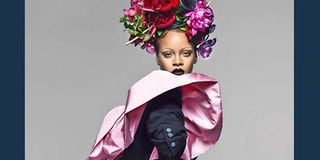The 90s are back!

Rihanna. PHOTO| COURTESY
What you need to know:
- Even Michelle Obama got herself a brow make-over when she was a First Lady.
- The comments sections were filled with reports on how she consequently looked less ‘angry’.
What does it mean when fashion says ‘the 90s are in?’ The same thing it means when they say orange is the new black or that denim is in. Confusion. After all, at no point did you stop wearing jeans, so how can they be in when they never even went out in the first place?
The peak of 90s style has to be the current Vogue cover. It has been the cause of many an opinion piece in the week it has been primed for.
Rihanna covers it with a fabulous former First Lady Lucy Kibaki ‘s eyebrow. A thin single line sketched in place of an eyebrow. Nowadays, eyebrows are thick, bushy, full, natural looking.
Even Michelle Obama got herself a brow make-over when she was a First Lady. The comments sections were filled with reports on how she consequently looked less ‘angry’.
Also, why would anyone ever want to relive 90s fashion? They were terrible years with androgynous wear by TLC and Aaliyah, those large pants that were obviously a crossover from Hammer pants. The music is still the most epic I have heard of in my lifetime. Kenyan music included. The videos though, are a smorgasbord of unsexy shoes and dark lip liner. But, something else more potent marked the 90s, and that was the rise of Hip Hop and R&B. Fashion and music were distinctly black. Not as politically blatant as the 60s and 70s were, but black power was dominant in pop culture. Should it really come as a surprise that during the Trump era expression against the establishment would be registered by revisiting the 90s? This was when the term ‘urban fashion’ to describe street style became popular lingo in advertising. Urban was a euphemism for style that originated from the streets, eventually inspiring the runways as opposed to the top-down theory where designers influenced what people wore by first placing it on the runways. Street style is about the zeitgeist, mood of the day, a representation of what is happening in society at the moment and who is making it happen. In the 90s, it was Hip Hop.
FORMIDABLE LIST
Dungarees, baseball jerseys, women with taut mid-sections in athletic wear — Britney, Christina, TLC, Aaliyah, Mya, Toni Braxton. It’s a formidable list that introduced the world to women’s fitness and a visual brand of feminism where they claimed their sexual power (or were forced to by music executives), and the inevitable perks, varsity jackets, monochrome, thigh high boots, statement earrings, fur coats, leather, and yes, mermaid hair. They were the Baby Phat years. Girlfriends, Moesha, The Parkers, A Different World and Eve were popular sitcoms long before Netflix and TV series created complex female leads. Of course there was Martin and Fresh Prince of Bel Air. While the 90s have been building up in our closets steadily for the last five years, there have been calls for sitcom revivals, reboots and reunions.
It could be argued one should not live in the past. But that adage about knowing where you have come from to where you are going cannot apply more to this timeline. With the alt-right gleefully erupting, and the black community hyper aware of cultural appropriation, it was only a matter of time before the old became new. It is always imagined fashion is independent of politics. This part of the imagination must be severed, because fashion is nothing if not politically inspired. The most appreciated aspects of black culture are lifestyle related; food, fashion, music and yes, even film, despite the absence of multiple blockbusters. It goes without saying there are deeper reasons for the appreciation of Black Panther and why we are still enamoured of it.
There has never been a better time to revisit the 90s than Ombre lips, door knocker earrings, athleisure wear’s connection to fitness and wellness. Look at Missy’s comeback. Hip Hop always had a solid bond with Adidas, Nike and velour tracksuits. The conscious lyrics era had its own style as did gangsta rap on suited up Biggie Smalls. By the late 90s women in Hip Hop found their aesthetic. One we now identify as the sex vixen, be they South African, Nigerian or American. The legacy of Foxy Brown and Lil Kim. Hip Hop is single handedly responsible for how Africans perceive fashion from West, South to East Africa. It informs clothing lines, from Kanye West to Octopizzo’s and Khaligraph Jones’ sense of style. We know black style when we see it following decades of training.
It is in light of this that the absence of colour, not simply in skin tone, but pizzazz, in every aspect of business including Hollywood, has been brought to the world’s attention. Remember wiggers? White boys who wanted to be black when hip hop was cresting, being black was cool and appropriation not yet a thing? Hip hop is said to have been born on August 11, 1973 at the Bronx. Observe explosively sensitive African Americans flinching at slights. Then keep in mind the 90s language.





